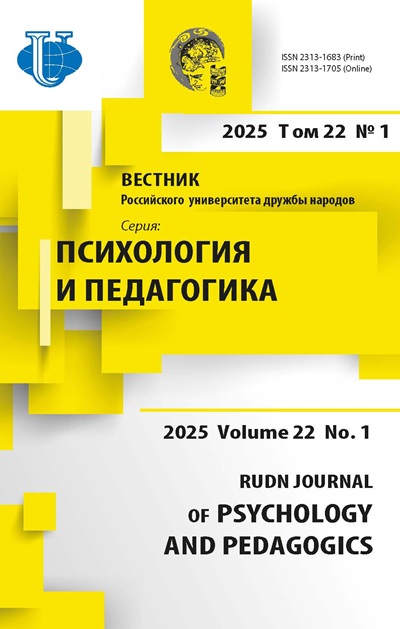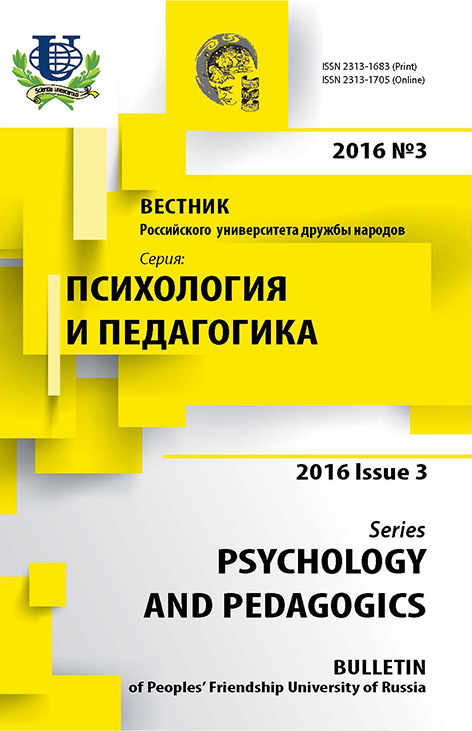ДИАГНОСТИКА ОГРАНИЧЕНИЙ В УПРАВЛЕНИИ РАБОЧЕЙ ПАМЯТЬЮ
- Авторы: Ершова РВ1, Юджин Т.2
-
Учреждения:
- Государственный социально-гуманитарный университет
- Авалон Бизнес Системс Инк
- Выпуск: № 3 (2016)
- Страницы: 14-19
- Раздел: Статьи
- URL: https://journals.rudn.ru/psychology-pedagogics/article/view/14423
- ID: 14423
Цитировать
Полный текст
Аннотация
Тесты на свободное воспроизведение включают два этапа: освобождение и реактивация следов памяти [6]. Tarnow Unchunkable тест (TUT, [8]) использует двузначные числа для того, чтобы исключить возможность реактивации следов, поскольку логическая связь между предъявляемыми числами отсутствует. В исследовании приняло участие 193 студента университета, измерение проходило с помощью сети Интернет с использованием TUT. Средний объем рабочей памяти для серии, состоящей из трех двузначных чисел, составил 2,54. Для серий, состоящих из четырех чисел, объем воспроизведения снизился до 2,38. Полученные результаты и данные качественной обработки результатов позволяют сделать вывод, что предельный объем рабочей памяти студентов составляет 3 единицы (двузначных числа). При переходе от 3 к 4 предъявляемым единицам среднее число воспроизведенных чисел снизилось, т.е. большая часть участников не смогла эффективно управлять своей рабочей памятью в процессе увеличения объема информации. Дополнительным доказательством этого вывода является то, что 25% студентов не смогли правильно воспроизвести хотя бы одну из трех серий, состоящих из четырех чисел, а корреляция индивидуальных результатов воспроизведения серий, состоящих из трех и четырех чисел оказалась относительно небольшой - 38%. Обнаруженные сложности в управления базовым ресурсом памяти имеют важное значение для педагогики (изменения в организации процессов обучения, дизайн учебников, содержание и дизайн проверочных заданий). Поскольку качество и объем рабочей памяти определяют уровень академических достижений, необходимо обучать студентов основам управления и развития рабочей памяти.
Ключевые слова
Полный текст
IntroductionFree recall, in which items in a list are displayed or read to subjects who are then asked to retrieve the items, is one of the simplest ways to probe short term memory. The corresponding serial position curve, the probability of recalling an item versus the order in which the item was presented, is u-shaped: items in the beginning of the presented list (primacy) and at the end of the list (recency) are more likely to be recalled than those in the middle of the list (see Fig. 1, left panel). Another way to think about recency and primacy is that both represent task interruption, invoking the Zeigarnik effect.It was recently shown explicitly that free recall is a well defined two stage process ([5]; this had been suggested before, for a review see [4]). In the first stage, working memory is emptied. In the second stage, a different retrieval process occurs. In the word item test in [3], working memory is responsible for recency and some primacy for short lists (see Fig. 1 right panel). The amount of recency and primacy is dependent on the algorithm used by each subject when remembering the recall [6]. Some subjects attempt to remember the first few words with a resulting primacy shape while the majority give up and attempt to remember the last few items [6].The TUT attempts to separate out just the first stage of free recall, working memory, by using particular double-digit combinations which lack intra-item relationships, minimizing inter-item associative strengths [2], so that the second reactivation stage does not occur.14Ershova R.V., Tarnow Eugen. Working Memory Capacity Test Reveals Subjects Difficulties Managing...100%90%80%Total recall70%60%50%40%30%20%10%0%10-20 2 4 6 8 10Item number30%25%Tnitial recall20%15%10%5%0%10-20 2 4 6 8 10Item numberFig. 1. Left panel: the famous u-shaped curve of total recall versus word number [4]. Ten word items were displayed at a rate of one item per two seconds. Right panel:Initial recall of Murdock [4], representing the distribution of words items in working memoryMethodOne hundred and ninety-three Russian undergraduate students of the State University of Humanities and Social Studies (121 (63%) - females and 71 (37%) - males, mean age = 18.8) participated in the study for extra credit. The test was conducted in a distraction free room. One record was discarded - the student had only one response.The TUT is copyrighted and patent pending from Tarnow [8]. It consists of six 3-item tests and three 4-item tests in which the items are particular double-digit integers.ResultsTotal Recall. The distribution of 0-3 correct items in the 3-item test is displayed in Fig. 2 (left panel). A binomial distribution does not describe the data, the distribution is best fit with an exponential (see fitted line). The average number of items remembered is 2.54.In Fig. 2 (right panel) is displayed the distribution of 0-4 correct items in the 4 item test. It looks qualitatively different from the distribution in the 3 item test. The 4 item distribution peaks at 3 correct items, a binomial distribution does not describe the data. The peak of the distribution in Fig. 2 (right panel) implies that most of the subjects cannot remember more than 3 items. The average number of items remembered is 2.38, lower than for the 3-item test!That the average remembered is lower for the 4-item test than for the 3-item test suggests that the subjects are not managing their limited capacity memory properly. This lack of management presumably explains why there is a very low (Pearson = 0.38) correlation between the subject total recall from the 3 and 4 item distributions. Indeed, in Fig. 3, left panel, is shown the difference in average number of items remembered in the 4-item versus the 3-item test. Negative numbers denotes a lower score in the 4-item experiment. Most participants score lower (right panel Fig. 3).15Вестник РУДН, серия Педагогика и психология, 2016, № 3900800700600Trials5004003002001000y = 23.976e1.1859xR2 = 0.99160 1 2 3Items recalledExperiment Bionomial fit250200Trials1501005000 1 2 3 4Items recalledExperiment Binomial fitFig 2. Left panel: Distribution of number of recalls with 0-3 correct items for the 3-item test (filled circles). A least square best fit binomial distribution (unfilled circles) with p = 88.5% does not describe the result (chi square = 3 · 10-14). A least square exponential fit (fitted line) is much better (chi square = 0.042). Right panel: Distribution of number of recalls with 0-4 correct items for the 4-item test (filled squares).A best fit binomial distribution (unfilled squares) with p = 66% does not describe the result (chi square < 1 · 10-53).35Number of subjects302520151050-3 -2 -1 0 1 2 3Difference in 4-item and 3-item recall250Number of subjects200150100500-3 -2 -1 0 1 2 3Difference in 4-item and 3-item recallFig. 3. Left panel: Difference average number of items remembered in the 4-item versus the 3-item experiment. Right panel: integrated differences - most subjects score lowerThe distribution of perfect 3-item scores is shown in the left panel of Fig. 4. In 5 out of 6 3-item trials 47% of the participants were able to recall all three items. 99% of all the participants were able to recall all three items at least once.601405012040301008060Number of subjectsNumber of subjectsy = 104.3x-1.311R2 = 0.9703201000 1 2 3 4 5 6Trials with perfect recall402000 1 2 3Trials with perfect recallFig. 4. Left panel: Number of perfect recalls in 3-item experiment. Right panel: Number of perfect recalls in 4-item experiment. The distribution is similar to a power relationshipThe distribution of perfect 4-item scores is shown in the right panel of Fig. 4. In contrast, 60% were not able to remember all items in any of the three 4 item trials. In each 4-item trial 24% of the participants were able to recall all four items (equally16Ershova R.V., Tarnow Eugen. Working Memory Capacity Test Reveals Subjects Difficulties Managing...distributed across trials). 40% all the participants were able to recall four items at least once.Serial Position Curves. That binomial distributions do not describe the data means that the items are not remembered and forgotten with equal probability. Indeed, the serial position curves in Fig. 5 show that these probabilities are not constant.The error rate as a function of serial position is shown in Fig. 6. The upper panel shows that the error rate for the 3-item test starts out very low and increases exponentially. The bottom panel shows that the error rate for the 4-item test is qualitatively different. It starts out much higher and increases logarithmically.100%90%Probability of recall80%70%60%50%40%30%20%10%0%1 2 3Serial position80%70%Probability of recall60%50%40%30%20%10%0%1 2 3 4Serial positionFig. 5. Left panel: Serial position curve for the 3-item experiment. There is no recency effect, presumably because the test started with 3 items which everyone can do and froze in that algorithm.Right panel: Serial position curve for the 4-item experiment30%25%Percent errors20%y = 0.0207e0.8668xR2 = 0.998660%50%Percent errors40%y = 0.2189ln(x) + 0.2582R2 = 0.999315%30%10%20%5% 10%0%1 2 3Serial position0%1 2 3 4Serial positionFig. 6. Left panel: The errors increase exponentially with position for the 3-item lists.Right panel: The errors increase logarithmically with position for the 4-item listsDiscussionWe found that for most subjects, working memory is limited to three items. When an additional item is added, most subjects remember less, indicating that they do not manage their working memory well at that point: if those with a three item limit managed their limit properly then they would simply focus on three of the items in the 4-item test and sustain the performance from the 3-item test.It may be possible to make people aware of their precise working memory capacity limits. If this occurs, limiting information intake should maximize the content of working memory. A well managed memory is important for learning and it has been suggested that “early screening to identify the strengths and weaknesses of a student’s working17Вестник РУДН, серия Педагогика и психология, 2016, № 3memory profile can lead to effective management and support to bolster learning” (see [1] and references therein). Here we suggest that in addition to managing the presentation to the working memory profile of the student, the individual skill to manage one’s own working memory is important.The distribution of total recalls is not binomial, indicating that the items are not treated the same by working memory. Indeed, the serial position curves show monotonically decreasing primacy - on average previous items are always more easily remembered than subsequent items.Many properties of the test results show differences between the 3-item test and the 4-item test. The distribution for remembering 3 items is close to exponential (χ2 = 0.042), while the distribution for remembering 4 items has not been identified. The distribution for perfect recall for 3 items has not been identified but the distribution for perfect recall for 4 items is close to a power law (χ2 = 0.47). Errors increase exponentially with serial position for the 3 item test (χ2 = 0.98) but logarithmically for the 4 item test (χ2 = 1.00).×
Об авторах
Р В Ершова
Государственный социально-гуманитарный университетул. Зеленая, 30, Коломна, Россия, 140411
Тарноу Юджин
Авалон Бизнес Системс Инк18-11 Радберн Роад, Фейр Лоан, Нью-Йорк, США, 07410
Список литературы
- Alloway T.P., Alloway R.G. Investigating the predictive roles of working memory and IQ in academic attainment. Journal of experimental child psychology. 2010, vol. 106, no. 1, pp. 20-29.
- Deese J. On the prediction of occurrence of particular verbal intrusions in immediate recall. Journal of Experimental Psychology. 1959, vol. 58, no. 1, pp. 17-22.
- Ershova R.V., Varchenko N.N., Gankin K.A., Semina T.M., Omelchanko E.V., Erofeeva M.A. The Psychological Health of Russian Students. Penza psychological newsletter. 2015, vol. 1, no. 4, doi: 10.17689/psy-2015.1.5
- Murdock B. The serial position effect of free recall. Journal of Experimental Psychology. 1962, vol. 64, no. 5, pp. 482-488.
- Murdock B.B. Human memory: Theory and data. Lawrence Erlbaum, 1974.
- Tarnow E. First direct evidence of two stages in free recall and three corresponding estimates of working memory capacity. Bulletin of Peoples’ Friendship University of Russia. Series: Psychology and Pedagogy. 2015, no. 4, p. 15-26.
- Tarnow E. Large individual differences in free recall. Assesed: https://www.researchgate.net/publication/271589189_Large_individual_differences_in_free_recall
- Tarnow E. U.S. Patent Application No. 14/066,195. 2013.
Дополнительные файлы















